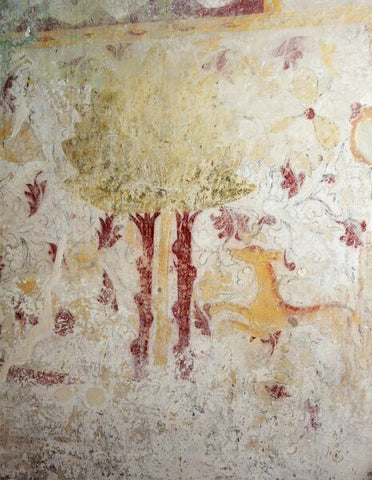Wall Paintings at Ellys Manor House

A rare and magical Tudor wool merchant’s house, built in the Flemish style, Ellys Manor House is an architectural gem.
The main feature of the house is a fabulous scheme of early 16th century wall paintings in the upper rooms.
Described by architectural historian Sir Nikolaus Pevsner as, “a rare English interpretation of French verdure tapestries”. The wall paintings dated around 1500 are said to be “the most complete, extensive and important domestic decoration of this date in the country.”
A truly continental house, reflecting the Northern Renaissance. The building and paintings are of outstanding historical interest: Pevsner, The Buildings of England. An absolute ‘Must See!’
Medieval Wall Paintings
The late medieval wall paintings at Ellys Manor House are among the most beautiful of their period in the country. That the paintings survive at all can be seen as miraculous, as in the 1940’s, when the house was a rectory, the walls of the house were reported as “running with water”, and that puddles were forming on the floor. When the incumbent complained about this to his superiors, no solution to the problem was suggested other than that the Rector instructed his wife to” mop up the puddles with a cloth”.
The first record of the wall paintings was in the 1930’s when the eminent Dr. E. Clive Rouse made drawings of the two small sections of painting that had been found. These were subsequently published in the Journal of the Royal Archaeological Institute. By the 1950’s the extent of the paintings became clear and, because of the expense that would be incurred by a conservation team, Dr. Rouse took the unusual step of suggesting that the Rector undertook the uncovering and cleaning himself and demonstrated to him how this should be done.

The paintings at Ellys Manor House are reminiscent of tapestry. However, wall paintings must not be seen as a ‘poor man’s tapestry’, as is sometimes suggested. There are many examples of domestic wall paintings that negate this argument. In the Portcullis Chamber of the Tower of London there is a very fine example, painted in the reign of Richard II, of St. Michael weighing the Souls of the Dead included in the painted decoration. Later examples are the two cycles at Hill Hall, Essex painted for Sir Thomas Smith, ambassador to France, statesman and scholar. There the Cupid and Psyche cycle is taken from a series of engravings by the Master of the Die and Veneziano and is painted to resemble tapestry, it is even given a rich border and fringed edges. Another example of a building where the owners could well afford tapestry and perhaps had it in conjunction with wall paintings, as the Tower of London most certainly did, is North Mymms Park, Hertford.
The use of wall paintings suggests confidence, stability and prosperity. They are not portable, to be moved as Royalty or noblemen moved their furnishings when travelling from one establishment to the next. Perhaps another consideration is vermin. Shakespeare makes a reference to “Fly-bitten tapestries” in Henry IV, (pt. II). Because they are not portable, wall paintings do not generally feature in inventories as tapestries do.



